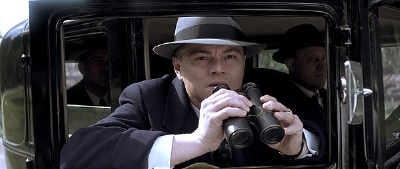J. Edgar: Elegant Oyster Soup Recipe 🥁🥁🥁1/2
/Year Released: 2011
Directed by: Clint Eastwood
Starring: Leonardo DiCaprio, Judi Dench, Naomi Watts, Armie Hammer
(R, 137 min.)

"The urge to save humanity is almost always only a false face for the urge to rule it." H. L. Mencken
If one is willing to accept a narrative that plays fast and loose with the facts, fleshing out rumored skeletons in the closet with careless abandon, then, in fact, one might call this film an artistic triumph. It certainly succeeds in portraying American icon J. Edgar Hoover as all too human; indeed, as an eccentric driven by a lust for power.
All of which may or may not be true. It certainly makes for good drama, perhaps in the same way Shakespeare’s not necessarily accurate historical portrayals did. His Brutus was an idealist not a traitor, while Macbeth, benign historically, became the epitome of ruthless ambition run amok.
Playing the man whose name is synonymous with the FBI, Leonardo Dicaprio reminds us of his role as Howard Hughes in The Aviator, whom he played as “eccentric with all the hysterical heights and manic madness that led him to triumph and disaster. He (Hughes) is at once a charming cad, a chivalrous jilted lover, and an almost pedophilic procurer.” The same intense relationship with his mother – in The Aviator there is a strong undercurrent of obsession infused with psychosexual overtones – appears in J. Edgar as well.
The redoubtable Judi Dench, playing Hoover’s mother, exudes all the quite authority she wields as the formidable M in the Bond series, and tempers it with a curdled and smothering maternal instinct. Early on J. Edgar proposes to his secretary, Helen Gandy, played superbly by Naomi Watts, who manages to mute her blond charisma into dull mousy dedication as his life long personal secretary. She rejects his offer, preferring to devote herself to her work. So Hoover continues to live at home with his mother and his senile/mad father. Later on, he alludes to an affair with actress Dorothy Lamour and considers marrying her, but his longtime friend and ally, Clyde Tolson (Armie Hammer) nips this idea in the bud.
Well, you could say he even nips J. Edgar as well, admitting his homoerotic love for the FBI director in a burst of angry passion, his forced kiss drawing blood. Here it is significant to note that the film is written by LGBT rights activist Dustin Lance Black, who won an Oscar for best screenplay in the film Milk, about the life and “martyred” death of Harvey Milk, the first openly gay man elected to public office in California. He has chosen in this film to portray the rumored accounts of J. Edgar Hoover as a bisexual repressing his gay predilections. The film does not show an overt sexual relationship between Tolson and Hoover, but an emotional psychosexual one.
The rumors of cross-dressing are handled with sensitivity. After his mother’s death, .J Edgar places her pearls around his neck and holds her gown against his body, almost as though he wants to keep her alive by becoming her. Not quite as creepy as Norman in Alfred Hitchcock’s classic Psycho, but certainly not what most of us envision when we think of the man who more or less created the FBI out of whole cloth.
Some would argue with this presentation, namely M. Stanton Evans, who voices a different political perspective:
An inordinate amount of screen time is devoted to showing that Hoover and his FBI Associate Director Clyde Tolson were homosexuals (Hoover repressed, Tolson overt) - in essence, Brokeback Mountain at the Bureau. But all of this is insinuation and surmise, as private scenes between the two are by their nature sheer invention.
But Evans objects to what he sees as more damaging inaccuracies and innuendos that show Hoover as a “would-be tyrant and political bully.” The infamous FBI tapes, in particular those depicting a lesbian affair of Eleanor Roosevelt, he insists, were obtained by the Army counterintelligence not the FBI.
And while the film shows loyal secretary Helen Gandy methodically shredding all the FBI’s official and confidential files upon Hoover’s death so as they would not fall into the evil hands of Richard Milhous Nixon, this is purportedly total fiction. These files do, in fact, still exist today, at least in part, and can be obtained through the Freedom of Information Act.
In cutting this iconic law and order man down to size, one wonders if octogenarian director Clint Eastwood is attempting to exorcize his Dirty Harry past. The flawed human that he captures on screen may or may not be the real J. Edgar Hoover. Yet, his portrayal is personal and moving, and in its own way, balanced as well.
—Kathy Borich

Film-Loving Foodie
Every day J Edgar Hoover and his Associate Director Clyde Tolson would meet for lunch at Old Harvey Restaurant adjacent to the Mayflower Hotel.
“Harvey’s Restaurant was a four-story, iron-fronted building erected shortly after the Civil War. It was the city’s oldest and most famous restaurant for sixty-six years.
Though the original structure was built circa 1820, the building was completely remodeled in 1866 by the Harvey brothers for their restaurant, originally known as Harvey's Ladies' and Gentlemen's Oyster Saloon. Every President from Ulysses S. Grant to Franklin D. Roosevelt dined in the building.”
Let’s try to recreate some of that history and elegance from Harvey’s Ladies’ and Gentlemen’s Oyster Saloon with our delicious recipe for Elegant Oyster Soup, steaming with artichoke hearts, mushrooms, real butter, and of course, the 12 freshly shucked oysters.
We may not be past Presidents of the United States, or even the Director or Associate Director of the FBI, but we can dine as they did, nevertheless.
Who knows, after this delicious soup, you may even track down a criminal or two.
Elegant Oyster Soup
2 tablespoons butter
1/2 cup carrot, finely chopped
1/2 cup onion, finely chopped
1/2 cup celery, finely chopped
1/2 cup button mushrooms, chopped
1/2 cup butter
1/4 cup all-purpose flour
1 quart chicken broth
1 (14 ounce) can artichoke hearts, drained
1 bay leaf
3/4 teaspoon salt
1/2 teaspoon cayenne pepper
1/4 teaspoon dried thyme
1/4 teaspoon dried oregano
1/4 teaspoon dried sage
1 cup heavy cream
12 shucked oysters and juice
Directions
In a large pot, saute chopped carrot, onion, celery and fresh mushrooms in 2 tablespoons of butter for 5 minutes or until the onions are transparent.
In another large pot, melt 1/2 cup butter and stir in the flour. Cook for 5 minutes.
Whisk in the chicken broth to the flour mixture. Add the sauteed vegetables, artichokes hearts, bay leaf, salt, cayenne pepper, thyme, oregano and sage. Simmer for 30 minutes over medium heat.
Whisk in cream and add oysters; bring to a simmer, but do not boil.
Recipe Source: allrecipes.com
















